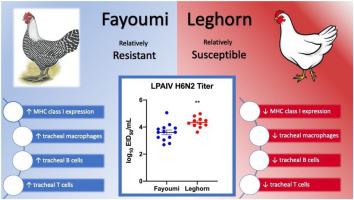Veterinary Immunology and Immunopathology ( IF 1.8 ) Pub Date : 2021-03-24 , DOI: 10.1016/j.vetimm.2021.110233 Emily J Aston 1 , Ying Wang 1 , Karen E Tracy 1 , Rodrigo A Gallardo 2 , Susan J Lamont 3 , Huaijun Zhou 1

|
Low pathogenicity avian influenza causes mild disease involving the respiratory, gastrointestinal, and reproductive systems of wild and domestic birds. Avian influenza research often emphasizes the effect of the virus genetics on disease, but the influence of host genetics on resistance to infection is not well understood. The genetic determinants of enhanced resistance to influenza can be explored by using genetically distinct, highly inbred chicken lines that differ in susceptibility to influenza. In this study, we compared the mucosal cellular immune responses between the relatively resistant Fayoumi M43 chicken line and the relatively susceptible Leghorn GB2 chicken line after challenging with low pathogenicity avian influenza virus (LPAIV) H6N2.
The birds were inoculated at 21 days of age with 107 50 % egg infective dose (EID50) LPAIV H6N2 via nasal and tracheal routes in two separate experiments. Clinical signs were recorded, tracheal swabs were collected to measure viral titer, and tracheas and lungs were harvested for flow cytometric analysis of macrophage, B cell, and T cell populations at 4 days post-infection (dpi) (Experiments 1 and 2) and 6 dpi (Experiment 2). Blood and tears were also collected at 7 and 14 dpi (Experiment 1) to measure antibody levels.
Compared to both the non-challenged Fayoumis and the relatively susceptible Leghorn chickens, relatively resistant Fayoumi chickens challenged with LPAIV demonstrated enhanced MHC class I expression on antigen-presenting cells and increased macrophage, B cell, and T cell frequencies in the trachea, which were associated with reduced tracheal viral titers at 4 dpi. In contrast, MHC class I expression and immune cell frequencies in the trachea were not different between challenged Leghorns and non-challenged Leghorns. Furthermore, Leghorns shed higher virus titers in their trachea compared to Fayoumis. Challenged Fayoumis and Leghorns both produced AIV-specific IgY detected in the serum and tears, but AIV-specific IgA was not detected in the tears. In this study, we provide new insight into immune mechanisms of enhanced resistance to avian influenza in chickens, which may lead to improved vaccination strategies and breeding programs.
中文翻译:

两种基因不同的高度近交鸡系对禽流感病毒的细胞免疫反应的比较
低致病性禽流感会导致轻度疾病,涉及野生鸟类和家禽的呼吸系统、胃肠道和生殖系统。禽流感研究往往强调病毒遗传学对疾病的影响,但宿主遗传学对感染抵抗力的影响尚不清楚。可以通过使用对流感的易感性不同的基因不同、高度近交的鸡系来探索增强流感抗性的遗传决定因素。在这项研究中,我们比较了低致病性禽流感病毒 (LPAIV) H6N2 攻击后相对抗性的 Fayoumi M43 鸡系和相对易感的 Leghorn GB2 鸡系之间的粘膜细胞免疫反应。
在两个单独的实验中通过鼻和气管途径在21 日龄时用 10 7 50 % 鸡蛋感染剂量 (EID 50 ) LPAIV H6N2接种这些鸡。记录临床体征,收集气管拭子以测量病毒滴度,并在感染后 4 天 (dpi)(实验 1 和 2)收集气管和肺用于巨噬细胞、B 细胞和 T 细胞群的流式细胞术分析6 dpi(实验 2)。还在 7 dpi 和 14 dpi(实验 1)收集血液和眼泪以测量抗体水平。
与未攻击的 Fayoumis 和相对易感的 Leghorn 鸡相比,用 LPAIV 攻击的相对抗性 Fayoumi 鸡在抗原呈递细胞上表现出增强的 MHC I 类表达,并增加气管中的巨噬细胞、B 细胞和 T 细胞频率,这是与 4 dpi 气管病毒滴度降低有关。相比之下,受攻击的来航和未受攻击的来航在气管中的 MHC I 类表达和免疫细胞频率没有差异。此外,与 Fayoumis 相比,Leghorns 在其气管中释放出更高的病毒滴度。受攻击的 Fayoumis 和 Leghorns 均在血清和眼泪中检测到 AIV 特异性 IgY,但在眼泪中未检测到 AIV 特异性 IgA。在这项研究中,



























 京公网安备 11010802027423号
京公网安备 11010802027423号